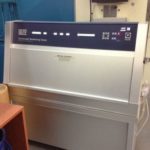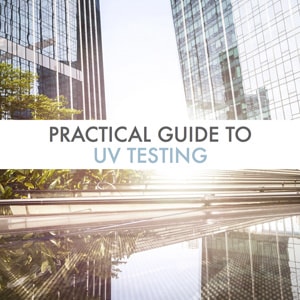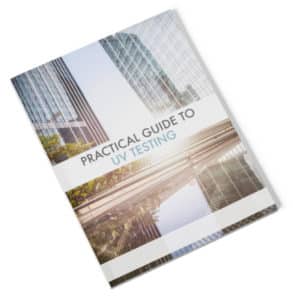Essais QUV
Essais de vieillissement accéléré

Le service d’essai QUV est utilisé afin de simuler l’exposition du soleil tant à l’intérieur, qu’à l’extérieur sur les finis de surface, les revêtements et les polymères. ASTM G154 est une méthode utilisée lors des essais de QUV. Toutefois, il existe une panoplie de méthodes d’essai qui requièrent l’utilisation du QUV. La liste des méthodes d’essai suivantes représente les services offerts chez Micom dans le domaine des essais QUV :
Les méthodes d’essais suivantes sont pour les essais QUV :
Adhésifs et scellants
- ASTM C1184, Specification for Structural Silicone Sealants
- ASTM C1257 – Standard Test Method for Accelerated Weathering of Solvent-Release-Type Sealants
-
ASTM C1442, Standard Practice for Conducting Tests on Sealants Using Artificial Weathering Apparatus
- ASTM C1501, Standard Test Method for Color Stability of Building Construction Sealants as Determined by Laboratory Accelerated Weathering Procedures
- ASTM C1519 – Standard Test Method for Evaluating Durability of Building Construction Sealants by Laboratory Accelerated Weathering Procedures
- ASTM C732 – Standard Test Method for Aging Effects of Artificial Weathering on Latex Sealants
- ASTM C734 – Standard Test Method for Low-Temperature Flexibility of Latex Sealants After Artificial Weathering
- ASTM C793 – Standard Test Method for Effects of Laboratory Accelerated Weathering on Elastomeric Joint Sealants
-
ASTM D904, Standard Practice for Exposure of Adhesive Specimens to Artificial Light
-
ASTM D5215, Standard Test Method for Instrumental Evaluation of Staining of Vinyl Flooring by Adhesives
Encre pour impression
- ASTM D3424 – Standard Practice for Evaluating the Relative Lightfastness and Weatherability of Printed Matter
- ASTM F1945, Lightfastness of Ink Jet Prints Exposed to Indoor Fluorescent Lighting
Général
-
ASTM G151, Standard Practice for Exposing Nonmetallic Materials in Accelerated Test Devices that Use Laboratory Light Sources
-
ASTM G154 testing, Standard Practice for Operating Fluorescent Light Apparatus for UV Exposure of Non-Metallic Materials
-
British Standard BS 2782: Part 5, Method 540B (Methods of Exposure to Lab Light Sources)
-
Colts Standard Test – UV Dye Resistance to Fade – QUV
-
GB/T 14522 – Artificial Weathering Test Method for Plastics, Coatings, and Rubber Materials used for Machinery Industrial Products – Fluorescent UV Lamps
- GB/T 16422.3 General – Plastics – Methods of exposure to laboratory light sources – Part 3: Fluorescent UV lamps
- GB/T 30669 General – Textiles – Tests colour fastness – Colour fastness to light yellowing
- GB/T 31899 General – Textile – Tests for weather resistance – UV light exposure
- ISO 4892-1 (EN) (DIN) General Plastics – Methods of Exposure to Laboratory Light Sources – Part 1: General guidance
-
SAE J2020, Accelerated Exp. of Automotive Exterior Matls Using a Fluorescent UV/Condensation Apparatus
Photovoltaïque
- ASTM E3006 – Standard Practice for Ultraviolet Conditioning of Photovoltaic Modules or Mini-Modules Using a Fluorescent Ultraviolet (UV) Lamp Apparatus
- GB/T 19394 – UV test photovoltaic (PV) modules
- IEC 61215 – Crystalline Silicon Terrestrial Photovoltaic (PV) Modules – Design Qualification and Type Approval
- IEC 61345 – UV Test for Photovoltaic (PV) Modules
Plastiques et élastomères
-
ASTM D1248, Standard Specification for Polyethylene Plastics Extrusion Materials for Wire and Cable
- ASTM D1148 – Standard Test Method for Rubber Deterioration-Discoloration from Ultraviolet (UV) and Heat Exposure of Light-Colored Surfaces
- ASTM D4101 – Standard Specification for Polypropylene Injection and Extrusion Materials
- ASTM D4329, Standard Practice for Light/Water Exposure of Plastics
-
ASTM D4674, Test Method for Accelerated Testing for Color Stability of Plastics Exposed to Indoor Fluorescent Lighting and Window-Filtered Daylight
-
ASTM D5208, Standard Practice for Exposure of Photodegradable Plastics
-
ASTM D6662, Standard Specification for Plastic Lumber Decking Boards
- ASTM D750 – Standard Test Method for Rubber Deterioration Using Artificial Weathering Apparatus
- ASTM D882 – Standard Test Method for Tensile Properties of Thin Plastic Sheeting
- ASTM D925 – Standard Test Methods for Rubber Property—Staining of Surfaces (Contact, Migration, and Diffusion)
- ASTM F1164 – Standard Test Method for Evaluation of Transparent Plastics Exposed to Accelerated Weathering Combined with Biaxial Stress
- GB/T 16422.1 – Plastics-Methods of the exposure to laboratory light sources Part 1: general guidance
- GB/T 31881 – Accelerated weathering test methods of automotive nonmetal components and materials using a fluorescent UV and condensation apparatus
- ISO 29664 – Plastics – Artificial weathering including acidic deposition
- ISO 4892, Plastics – Methods of Exposure to Laboratory Light Sources-Part 3: Fluorescent UV Lamps
- ISO 4892-2, Plastics – Test conditions duplicating weathering effects on plastic components
- ISO 4892-3, Plastics – Test conditions replicating weathering effects on plastic materials through the use of moisture and xenon arc light
Revêtements
- AAMA 624 – Voluntary Specification, Performance Requirements and Test Procedures for High Performance Organic Coatings on Fiber Reinforced Thermoset Profiles
- AATCC TM186 – Weather Resistance: UV Light and Moisture Exposure
- ASTM D3451 – Standard Guide for Testing Coating Powders and Powder Coatings
- ASTM D4587, Std. Practice for Light/Water Exposure of Paint
- ASTM D5894, QUV combiné avec la corrosion cyclique
- ASTM D6577 – Standard Guide for Testing Industrial Protective Coatings
- EN 13523-10 (DIN) – Coil Coated Metals – Test Methods Part 10: Resistance to Fluorescent UV Radiation and Water Condensation
- GB/T 23983 – Test method for yellowing resistance of wood coatings
- GB/T 23987 – Paints and varnishes – Exposure of coatings to artificial weathering – Exposure to fluorescent UV lamps and water
- GM 4367M Topcoat Materials – Exterior
-
GM 9125P Laboratory Accelerated Exposure of Automotive Material
-
ISO 11507, Exposure of Coatings to Artificial Weathering-Exposure to Fluorescent UV and water
-
ISO 20340, Performance Requirements for Protective Paint Systems for Offshore and Related Structures
-
NISSAN M0007, Fluorescent UV/Condensation Test
-
prEN 927-6– Pt. 6: Exposure of Wood Coatings to Artificial Weathering Using Fluorescent UV and Water
-
US Government, FED-STD-141B
Toitures
- ASTM D1670 – Standard Test Method for Failure End Point in Accelerated and Outdoor Weathering of Bituminous Materials
- ASTM D3105, List of Test Methods for Elastomeric and Plastomeric Roofing & Waterproofing
- ASTM D4434, Std. Specification for PVC Sheet Roofing
-
ASTM D4799, Test Method for Accelerated Weathering of Bituminous Roofing Materials
-
ASTM D4811, Std. Specification for Nonvulcanized Rubber Sheet Used as Roof Flashing
-
ASTM D5019, Std. Specification for Reinforced Non-Vulcanized Polymeric Sheet Used in Roofing Membrane
- CGSB-37.54-M, Canadian General Standards Board Spec. for PVC Roofing & Waterproofing Membrane
Autres méthodes d’essai en lien avec le QUV
Une alternative aux essais QUV est la méthode ASTM G155 qui utilise une source lumineuse de nature différente. Pour plus d’information concernant les techniques alternatives, veuillez vous référer au lien suivant: Essais de Weathering accéléré.
Finalement, suite à l’exposition selon ASTM G154, différentes mesures peuvent être prélevées afin de quantifier l’impact du vieillissement: Voir Essais ASTM, Essais de revêtements et Essais de polymères pour plus d’information.
Guide pratique pour essais UV
L’exposition aux rayons du soleil peuvent avoir des effets
néfastes sur les matériaux à base de carbone tels que les revêtements,
les polymères, les textiles et bien d'autres encore.
Pour en savoir plus sur notre processus de test UV en laboratoire,
consultez ce guide (en anglais seulement).



 Un livre électronique gratuit pour vous aider à mieux protéger vos produits des
Un livre électronique gratuit pour vous aider à mieux protéger vos produits des